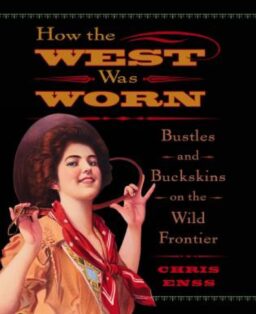Enter now to win a copy of
How the West Was Worn: Bustles and Buckskins on the Wild Frontier

Men and women have always distinguished themselves through fashion. The outfits they chose to wear reflected their performance of different jobs, as well as their roles in society. Due to a lack of availability, however, the average western pioneer did not have the luxury of choosing from a wide assortment of clothing to wear. The one or two outfits he did possess were selected to fit the harsh living and working conditions of the frontier.
Soon after the discovery of gold ushered a flood of newcomers into the western United States, conventional fashion changed dramatically. Men traded dress pants and ties for Levi’s jeans and bandanas. Ladies stowed away their expensive, hooped costumes and donned cheap calico and work boots. Because of such changes, an individual’s role in society could no longer be determined by the garments he or she wore.
The pioneer look was mostly born out of necessity and, at first, was more functional than ornamental. A lady’s billowing skirt and long flowing train were not practical for buckboard travel or frontier living. It was difficult for women to fulfill trail duties while bound in stiff whalebone waist cinchers and stubborn crinolines. Men needed to wear clothing that could withstand the ruffed terrain and harsh frontier weather. Children, too, adopted less restrictive attire, allowing them the freedom to work and play alongside their immigrant parents.
Fashion-wise, westward expansion equalized the masses, and within that period of changing styles, a new look emerged – a look that would enable the rest of the world to recognize a westerner no sight.

